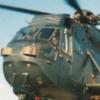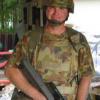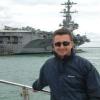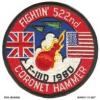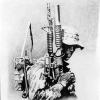Search the Community
Showing results for tags 'FAA'.
-
Folks, A little elf told me that Santa is bringing me the 1:48 Hasegawa Mk5 limited edition Sea King for Christmas. This kit comes with the barn door FOD shield and larger radome but not sure about the starboard extended sponson. I intend to make it a long term build and build it is a HAS6, airframe number XV711, callsign 09, as shown below. I will be sourcing the various after market PE etc as well as some scratch building.. but I am wondering what's the best way to go, in order to obtain the decals ?? It must be the aircraft shown below, as it was the last Sea King I crewed back in 96 and the picture below shows us at Old Warden back in July 1996 Is it best to TRY and make my own decals in order to supplement what's in the kit, for example the serial numbers and the claymore etc.. or are there companies/experts who can make 1:48 scale decals to order ?? Any advice would be appreciated. Thank You
- 17 replies
-
- 1
-

-
Here is my completed 1/48 FAA Hellcat done as Hellcat Mk 1, FN373/J of 1839 NAS, Eglington, Dec 1943 . I used a combination of Pollyscale and HUmbrol paints for the camouflage with a black wash on the panel lines with some Hu98 Chocolate for the exhaust weathering. The build log is at the link below: http://www.aussiemodeller.com.au/forum/viewtopic.php?f=8&t=8818
-
I have been building this one since the start of 2014 and have finally gotten close to finishing it. The kit is the Eduard 1/48 F6F-3 'weekend edition' and has minimal markings and PE (thankfully), it is OOB except for using Xtradecal markings and adding the drop tank straps that were not done by Eduard. I have used a combination of Humbrol and Pollyscale acrylics for the cam and Humbrol Hu98 chocolate for the exhaust staining after a black wash was put on. I have to put all the small bits on then give it a coat of Humbrol Matt Varnish to finish it off.
-
Hi all. While waiting for the new Tamiya Corsair a question has wiggled it's way into my mind and just won't leave. What kind of bombs/rockets would a Corsair in FAA service be carrying - british or US made? Please expand this question to all US-built planes in FAA/RAF service during WW2. I seem to remember seeing P-40'es with british made bombs but does that also apply to FAA planes in the SEA theatre? Which brings forth another question: who makes WW2 british bombs/rockets in 1/32, 1/48, 1/72? Thanks for any input! Hans J
-
Here are a few images of my fourth 1/48 Tamiya Corsair Mk II done OOB using Techmod decals. The build log is at the link below: http://www.britmodeller.com/forums/index.php?/topic/234958127-a-flight-of-148-faa-corsair-mk-iis/
- 13 replies
-
- 14
-

-
In my personal group build of FAA Corsairs I have come to realise the distinct lack of stencil data for the FAA Corsairs as you can't use the minimal stuff provided by Tamiya and Xtradecal don't nprovide them. I have just bought the Techmod sets for the 1/48 Corsairs and Wildcats and they come with the stencil data. My question is - are there aftermarket stencil data for the Corsairs in FAA service in 1/48?
-
Whilst battling the AZ Models Firefly Mk 1 I thought I might knock together something a bit easier so I started the four Tamiya 1/48 Corsair F4U-1D's that I had sitting in the cupboard. All four are going to be FAA Corsairs using a variety of AM decals I have and are pretty much OOB. I have trimmed the wing tips and just given the interiors and engines a basic paint job as I am more interested in the exterior paint job as I did with my last FAA Corsair. I just love the Tamiya Corsairs as they are well engineered, easy and quick to build. You can also go to town on detailing them if you wish. Apart from airbrushing the interiors I only started these last night and have done a fair amount of work on them. At some stage I have to get more of them as I want to do two RNZAF Corsairs and maybe an FAA Corsair Mk IV at some stage.
-
Here is the third FAA Corsair I started not long ago. I found a small problem with the Tamiya kit in that the wings do not fold up to the correct position ie not close enough. I will be posting more of this one and the last of the four on Aussie Modeller in the near future. Here is the link to the other two I recently completed: http://www.britmodeller.com/forums/index.php?/topic/234961190-two-148-faa-corsair-mk-iis-completed/
-
Here are two of the four 1/48 FAA Corsairs that I have been working on recently. These two are completed but I have two more that I am making with the wings folded that are waiting the time available to work some more on them. One is done in FAA colours and the other is done in US equivalents. The link to the build is below: http://www.britmodeller.com/forums/index.php?/topic/234958127-a-flight-of-148-faa-corsair-mk-iis/
- 15 replies
-
- 21
-

-
Hi mates! This one took a bit longer than expected, but it's finally finished. This is the not-so-often praised kit of the not-so-often praised Blackburn Skua, as seen in the autumn of 1939 aboard HMS Ark Royal. This is an out-of-the-box build, somewhat unusual for me, the only bits I added that didn't come with the kit were the antenna wires and the ordnance. Project: Blackburn Skua Mk.II Kit: Special Hobby Blackburn Skua Mk.II "Silver Wing" (kit number 72217) Scale: 1:72 (the only scale that matters) Decals: From the kit, representing flight leader 803 Squadron, L2887/A7F aboard HMS Ark Royal in the autumn of 1939 Photoetch: From the kit Resin: From the kit Paint: Alclad 103 Dark Aluminum, 117 Dull Aluminum, 115 Stainless Steel, 107 Chrome; Gunze H90 Clear Red, H94 Clear Green, H93 Clear Blue, H5 Blue, MC219 Brass, Navy Bird Custom Gunze Blend for British Interior Green; Tamiya XF-69 NATO Black; Testors 1149 Flat Black, 1168 Flat White; Floquil 110015 Flat Weathering: Panel line wash, pastel shading on control surfaces, pastel shading on collector ring Improvements/Corrections Added port and starboard air outlets (top of fuselage forward of windscreen), parts made from leftover resin pour stubs. Added 500 lb. SAP (Semi Armor Piercing) bomb. Added clear plastic piece to represent windscreen armor plate. Added antenna with 0.005" diameter Nitinol wire. Build thread: Link This was a nice little kit. I found that it went together without any fuss, with very little filler required. The photoetch stays for the engine were a bit fiddly, but they really add some nice detail. Skuas from this time period were painted with an aluminum lacquer, which I represented by Alclad Dark Aluminum with an overcoat of Floquil Flat. This gives a nice even aluminum finish (without any of the grain one sometimes get with silver paint) and a semi-gloss, eggshell finish. Alclad Dull Aluminum was used for the control surfaces to differentiate them from the fuselage. I did a lot of research while building this model, and now have a much better appreciation for the Skua. Tony O'Toole helped a lot with my incessant quests for information, and Peter Smith's book of the Skua provided a great historical backdrop. Pictures! The Skua, of course, is the personal favorite of none other than the Dude himself. Abide! Cheers, Bill
- 61 replies
-
- 47
-

-
Hi folks, I was taking March off from modelling, pending a couple of upcoming GBs, when I decided to throw together a Revell Sea Hurricane, trying to correct a couple of outline errors in the process. The result is shown below as a rocket equipped SHurri IIC from HMS Vindex (I'm following a profile on Wings Palette, so don't know how accurate it is) but as a quick build, it met the need. Prop / spinner is from Quickboost, vacform sliding canopy is from Squadron (I think) and the rockets / rails I believe came from a Hi-Tech Smer kit of the IIC although I may be wrong. Anyway, the rest is hacked about Revell plastic. Decals are from the spares box apart from the s/n (which is from the kit and is therefore wrong for this aircraft). regards, Martin
- 6 replies
-
- 6
-

-
- Sea Hurricane
- FAA
-
(and 2 more)
Tagged with:
-
Hi, I have just finished building a FROG Barra, with as many improvements as I could incorporate (yes, I know; the final result is not that different). However, I had some fun building it and I'm pleased with the non-uniform paint finish. Things wot I did: -Scribed panel lines -Repositioned empennage ~3mm further forward, -Scratchbuilt a basic representative cockpit interior, -Scratchbuilt interior of engine intake, -Used some elements of the Airwaves etched brass set (designed for MPM kit) -Used some elements of the Aeroclub upgrade set (wheels and undercarriage bits are particularly nice). Hope you like it. regards, Martin
-

New Digital Decal Releases from Oldmodels Decals
Oldmodels Decals posted a topic in The Rumourmonger
Latest releases into the Oldmodels Decals Digital range are: RNZN Westland Wasp 1/48 and 1/72 in four schemes: 1960s delivery scheme (the RN scheme with NZ flight numbers and ships crests) 1970s-1990s scheme Last scheme “Orange Sprat” scheme (used for Bougainville peace talks) Available through my website www.oldmodelsdecals.com and TradeMe (for NZ customers only) John Oldmodels Decals -
Hello everyone, I am new to the forum and this is my first post. http://www.flickr.com/photos/50794715@N03/11820301843/ Here are my first three proper builds, all 1/48. They are, from left to right: Seafire Mk.XV SR572/112 of 1832 NAS (RNVR)1949; HMS Hornbill /RNAS Culham. This was the Revell kit in BPF markings. I folded one of the wings, scratch building the wing fold sections, and added rockets and drop tank from the Airfix XVII and drilled out the exhaust stacks. I also dropped the flaps and used some spares from the Airfix kit. The decals were from Freightdog, except the stencils. I couldn't find any reference pictures for this aircraft so it's a flight of fancy, combining some stencils from the Kit and some from the Airfix XVII. Lightly weathered with a pastel wash and exhaust staining with ground pastels. I also added a whip aerial. I found this a difficult kit to build and used a lot of filler, for the first time. Seafire FR.47 VP480/180 of 800 NAS on HMS Triumph 1950 (Korean Stripes). The Airfix 1/48 kit, Built out of box apart from seat belts from wine bottle foil, drilled out exhaust stacks and a whip aerial. Weathered with a pastel wash, with ground pastel exhaust stains and some light paint chipping around the cannon access panels. Decals from Freightdog were used to fill the gaps in the kit set. A really enjoyable kit but the wing folds are very fiddly. Seafire Mk XVII Sp343/126 of (RNVR) NAS 1832 early1950's HMS Hornbill /RNAS Culham. Built out of box apart from tamiya tape seat belts, and a whip aerial. Again a light pastel panel wash. Whip aerial is wonky but will be corrected later. A really simple kit to build http://www.flickr.com/photos/50794715@N03/11820434404/ http://www.flickr.com/photos/50794715@N03/11820851996/ http://www.flickr.com/photos/50794715@N03/11820452573/ http://www.flickr.com/photos/50794715@N03/11820289253/ I hope the pictures appear ok, as I'm working from an iPad Comments welcomed. Don't hold back and thanks for looking Justin H
-
Supermarine Attacker F.1 1:48 Trumpeter The Attacker was Britain's first jet fighter to fly with Fleet Air Arm in carrier operations, and was very much first generation, sharing much of the laminar wing design of the poorly received and short-lived Seafang (Spiteful in RAF service). It was also a tail-dragger, one of the last jets to use that configuration with twin main-wheels under the wings and small tail-wheel under the rear of the fuselage. While this served prop driven aircraft well and kept their props from striking the ground, the jet didn't have this requirement, and the consequential lack of vision from the cockpit over the nose was a real impediment, especially in carrier operations. The RAF rejected the Attacker because it didn't bring anything new to the party, but a navalised version was sold to the Admiralty, although its service life was incredibly short, lasting only three years of front-line service, during which it saw no action. The tail down stance, poor aerodynamics and handling, plus the rapid advance of jet aviation at the time saw it replaced by the Sea Hawk in active service, lingering on until 1957 in Royal Naval Volunteer Service before it was retired completely. Pakistan flew 36 land based aircraft designated Type 538 from 1953 until 1956 when they moved over to F-86 Sabres. The F.1 was the fighter variant, but there were also 11 FB.1 Fighter Bombers that were simply modified as they rolled off the production line to carry rockets and bombs. A later version, the FB.2 was upgraded with newer more powerful version of the Nene engine to give it more speed. A surprising 84 of this variant were built. The Kit The kit represents the initial F.1 variant, and is a welcome release, as previously the only kits in this scale were the competent Falcon vacformed kit and the now defunct Classic Airframes kit. Both could be tricky to build for the inexperienced modeller, and this new injection moulded kit should be pretty simple to build by comparison. It arrives in a standard fighter-sized box with a rather impressionistic painting of an Attacker flying over broken cloud. Inside are three sprues of mid-grey styrene in individual bags, plus a foam wrapped clear sprue in a card "corral", a small sheet of Photo-Etch (PE) parts, a medium sized decal sheet in its own bag, and the instruction booklet, which is landscape A4, and has the paint and decal instructions slipped into the middle. The sprues are well detailed, and have lost of raised and recessed detail moulded into the parts, with a sensible parts breakdown that should make construction straight forward. The inclusion of a set of PE seatbelts is a nice addition, although a few extra parts would have been nice. Shapewise, the parts match the CA kit pretty well, but as I don't have a Falcon kit in the stash, I can't compare with that. The wings of the Trumpeter kit are fractionally smaller in chord, as are the tail surfaces, and the engine intakes start slightly further back on the fuselage, but everything else seems to be "as close as makes no difference" as my dad is prone to saying. Construction starts unusually with the wings, which can be cut to fold the tips for stowage below decks. The lower half of the wing is a single length, including the underside of the fuselage, so seams will need to be filled at the front and rear of this section. The upside is that setting the dihedral of the wing will be a breeze. The gear bays are supplied as single tubs, and have some nice rib detail moulded in. There are a few odds and ends missing from the bays around the gear leg attachment area, but these can easily be added from photos if you're minded to. The upper wings are separate parts, and once installed leave a gap in the centre for the fuselage to be dropped. The cannons are moulded into the lower halve of the wings, with a pair of half-circular cut-outs in the top parts which is an improvement on the old CA kit's resin inserts. The current trend of installing the wheels during the major construction continues with this kit, and the detail is good, having separate oleo-struts, linkages for the gear bay doors, and two parts for the bay doors. The wheels are also nicely detailed, and are moulded in front and rear halves, with the seam hidden by the circumferential tread of the tyres. The wheels are ever-so-slightly smaller than the CA kit, but draw your own conclusions as to who is right there, as I'm not going to venture a guess! The flaps on the wings are separate parts built up from top and bottom halves, and these are glued into corresponding slots on the rear of the wing, split by a small hinge bearing section of wing that extends to the trailing edge. These can be posed at any angle you choose, but check your references to make sure that you do so to the aircraft's permitted range of movement. If you elected for the folded wing-tips, a pair of inserts and an L-shaped hinge are supplied for you to add to the cut wings to set them at the correct angle. The cockpit of the Attacker is a cramped and simple affair, with small side-consoles, a rail for the ejector seat on the rear bulkhead, and a curved instrument panel. The tub is quite nicely appointed, with some instruments and throttle quadrants present, but the throttle levels themselves are absent, making me wonder if they were originally scheduled for the PE fret, but were forgotten about somehow. They can be added using scrap PE and a blob of white-glue for the knob on the end if you see fit, but there won't be much visible once completed. The insides of the fuselage have some ribbing detail present which probably won't be seen either, but it is good that they have added it. A pair of rudder pedals are added to the front of the tub, and a control column just forward of the seat, with a simple black and white decal for the instruments on the main panel. The seat itself is comprised of an L-shaped cushion section, side panels, rear panel with the head-box added from four separate parts, and a set of PE seatbelt straps for the pilot. The Attacker was fitted with a Mark.2 Martin Baker manufactured ejection seat, and this had a slight convex curve to the top of the thigh-guards which isn't present on the kit parts. This can be remedied by a little careful sanding of the parts before gluing together, making reference to one of the many dedicated ejection seat sites out there, so shouldn't be an issue to the informed modeller with a sanding stick. The tail wheel fits into a small box of a bay which is devoid of detail, but hardly likely to be seen anyway. To give the wheel some strength, a flat mounting point is provided, which attaches to the front wall of the bay box. The angled exhaust pipe is supplied as a one-piece part to which a circular fan part representing the rear of the engine is attached. The three assemblies can then be sandwiched between the fuselage halves, with the cockpit coaming added at the same time. A pair of prominent circular intakes are added to the upper fuselage toward the tail, and these are supplied as slide-moulded parts with recessed intakes, which is good to see. The main intakes comprise of a splitter plate and the intake lip itself, one on each side of the fuselage. Both are well detailed with the auxiliary intakes on top of the intakes, and the splitter plates having the support vanes moulded into the back of them, setting the plate away from the fuselage sides. The wings can then be added to the completed fuselage and the seams filled and polished. The canopy is supplied as a two-part assembly, and is crystal clear with very little distortion present. A dip in Klear/Alclad Aqua Klear will improve the clarity further, and the separate windscreen allows the canopy to be posed open or closed as you see fit. The tail-hook, tail wheel doors and the strange instruments on the nose (which are supplied as PE parts) are the last of the mandatory parts, after which only the huge belly tank can be added as an option. This fixes to the underside of the aircraft between the wings, and will hide an awful lot of the fuselage to wing seam, so will be pretty tempting if you're not a fan of sanding and filling. It makes an unusual aircraft look downright strange to me, so could well be a candidate for fitting, just for the hell of it. In British service there is only one scheme, and that is FAA Extra Dark Sea Grey (EDSG) over Sky, with a high demarcation line that cuts through the tail plane line. The rudder is also painted sky, and the nose has a curved demarcation, which will be fun to mask! The usual post-war roundels with the white central ring reinstated are present on the fuselage and the wing tips, and large serials under the wing are also the order of the day. From the box, one of two schemes can be modelled, in the colour scheme above, with the following aircraft: WA496 coded 101, tail code J WP493, coded 106, tail code J Decals are well printed and have good colour density, but I can't help thinking that the red spots on the roundels are ever-so-slightly off-centre. If you agree, you'll need 6 16.5mm roundels to replace them, which although a bit of a pain isn't the end of the world. Conclusion There will be a lot of modellers that are very pleased to see a mainstream injection moulded kit of this important but short-lived early British jet, even though it was a bit poor in reality. It looks to me at least like a pretty good job has been done of it from perusing the sprues. A little more detail in the wheel wells and it should look great with some careful painting. Trumpeter are to be praised for filling in some quite remote nooks of British post-war aviation, as their catalogue expands every year to include some oddities that we'd never expected to appear in injection moulding. Highly recommended. Review sample courtesy of
-
Chaps and chapesses, I have recently bought a Hobby Boss Easy build Corsair F4U-4 and I had the idea of completing it as a late WWII FAA machine. If I wanted to be very subtle, I could build it in GSB as a BPF machine, but I quite fancied something in the ETO - perhaps as used in the invasion of Norway in late 1945. So, TSS would be a good guess, I'd have thought. However, when did the EDSG / Sky scheme come in for FAA machines? Was this something that could have happened when the war was on*, or was it a reaction to peacetime? If the former, it might look a bit different on a Corsair! Any thoughts? regards, Martin * Yep, I know: my what-if, my rules, but I'd like to make it not too "unbelievable", if you get my drift.
-
I watched the Disney film "Planes" a couple of weeks ago, fun film and full of little aircraft related jokes like "U.S.S. Dwight D. Flysenhower" I came across the Zvezda range of snap together models for the film (and "Cars", I can see a fully detailed Mater in my future...) online and the "Skipper Riley" F4U caught my eye. I wanted to build one for a bit of fun, adding some detail and fully paint it but then it struck me, why keep it as the film character? I decided to do a FAA Corsair II so I picked one up from Antics and opened it up at home and was really surprised with how much detail there was for what essentially is a kids kit. Finely engraved panel lines, rivet detail, beautifully detailed undercarriage and engine... Not at all what I was expecting! The only thing not catered for were the main gear doors but that was sorted with a little plasticard. I decided to drop the flaps which was a nightmare to do because that part of the wing is one piece and it took a long time to score/cut through them but eventualy they were free. Some card and sanding to round the edges and I made the little flap filler to finish them off and the only thing left was to clip the wings. I mixed all the paint colours buy eye using Revell acryilics and the decals were from the spares box. weathered with oil washes and pastels and a final coat of Tamiya satin varnish. I needed to name it, after a bit of thinking I came up with Ken Decklander. Ken, for my late grandfather who served in the Navy in WWII and Decklander because... You get the idea What it looks like out of the box. (It doesn't come with decals, stickers are supplied but this photo I found has been photoshopped )
-
Seen this on the local news - Barracuda Mike
- 11 replies
-
- 1
-

-
Not strictly a WIP, I know, but this is the only forum which encompasses all eras. Tomorrow is the annual open day for the FAA Museum reserve collection, and I am going with my trusty camera. In my case I am particularly looking for some pics of a) the Barracuda restoration project and a Harrier T4N, but I know I will end up taking loads of shots of others. Anyway; any particular requests?
-

Eduard F6F-3 Hellcat/FAA Hellcat Mk1
AnonymousDFB1 posted a topic in Ready for Inspection - Aircraft
Eduard Hellcat Mk.1 Fleet Air Arm, 1943-44 -
Just missed out on being first on the list.....again! Ok in to another one, this as usual will have lots of extras, though not too much in the way of modifications which will be nice for a change!! I’ll be building and Accurate Miniatures 1/48 Avenger TBF-1C I picked up in Singapore for next to nothing. With this I’ll be building and FAA Avenger MkI/Tarpon I JZ257 from 849 NAS, aboard HMS Victorious, British Pacific Fleet January 1945. Mouldings and details are lovely. I’ll be adding a few extra detail bits from Eduard, Quick Boost, DEF Model, as well as decals from XtraDecal. Got the BigEd set before I realised I had a TBF-1C and not a TBM-3, so have had to order the correct detail set, so will use both to complete this build. Sure I might need some for the second cockpit! Deacls are lovely as well. Said bit, forgot to take photos of TBF set, next post. Maybe a bit of an over kill, but they were cheap. The XtraDecal markings were for an Avenger MkII (TBM-1C), which I thought maybe an issue but after careful research I have found that these Decals were actually for an Avenger MkI (TBF-1C). There’s a great site which lists all the Bu. No’s assigned to each air craft which helped a lot, so that problem has been solved. Next is the issue of the second cockpit. Not too many photos are available, so this may not be 100% accurate but with a bit artistic license it should look fine. Am really looking forward to this build.
- 48 replies
-
- Accurate Miniatures
- Avenger
- (and 6 more)
-
This will be my build for the GB, part of a birthday gift package given to me by some very good friends. Not liking the scheme that came with the kit I decided on a FAA scheme I'll be doing it minus the D Day stripes so she will look something like this The kit is very nice and through the course of the day it flew together Cockpit Fuselage interior Assembled Wings Wings, Fuselage and Tailplanes Engine Engine Cowl More soon
-
Hobby Boss Corsair Mk V, HMS Implacable, Operation Olympic, late 1945: regards, Martin
-
Out of the box build not sure yet whether to do box scheme or all blue alternative
- 16 replies
-
I am looking for information on the markings of 802 Squadron Sea Gladiators on the HMS Glorious in the spring/summer of 1939. I have seen several profiles of one, the squadron commander's machine, presumably, G6A, serial N5519, like this one: A photograph in the Warpaint Gladiator monograph shows the squadron diamond pattern on the upper wing of this aircraft. I have seen it represented as being blue in some sources and yellow in others. Does anyone know for certain which is correct? It was for most of the inter-war period standard practice for the Royal Navy to paint metal panels grey, while aluminum dope was used on fabric. There is usually a perceptible difference, as in this picture of a Nimrod: In photographs of Sea Gladiators, such a difference in tone is not apparent. Were Sea Gladiators painted in over-all aluminum (like the aluminum paint applied to Skuas)? Were serials marked under the lower wings of Sea Gladiators? I have seen photographs showing such a marking, but none of the decal sets offered for G6A by various companies indicate such underwing serials. Finally, are the identities of any other 802 Squadron Sea Gladiators in this period known? Is there anywhere known, for example, what the serial number of G6B was? I presume, at least, there would have been a G6A down through G6I?
- 11 replies
-
- FAA
- Sea Gladiator
-
(and 1 more)
Tagged with:

